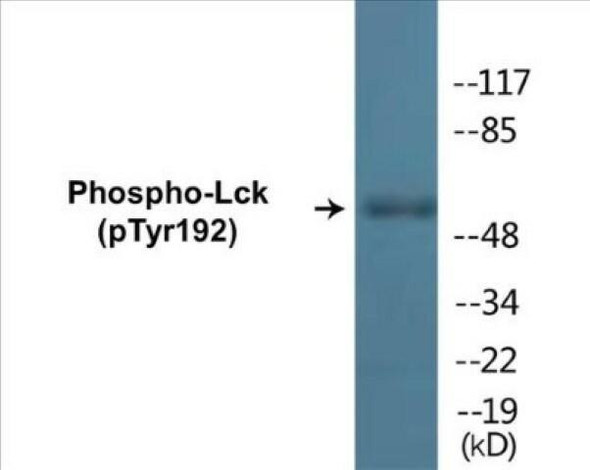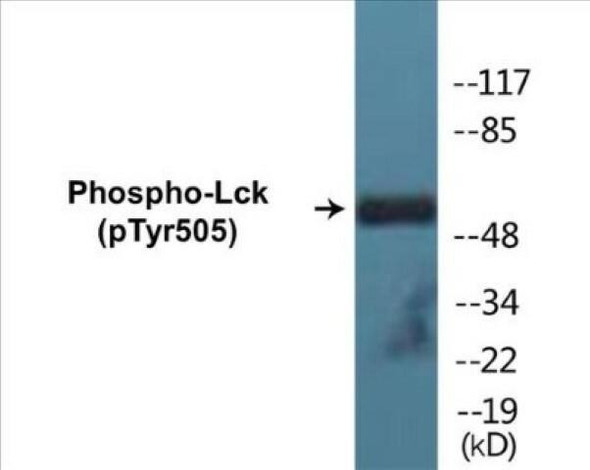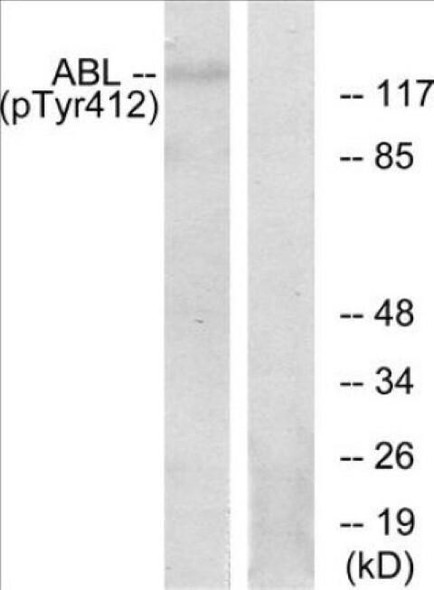Lck (Phospho-Tyr393) Colorimetric Cell-Based ELISA Kit (CBCAB01559)
- SKU:
- CBCAB01559
- Product Type:
- ELISA Kit
- ELISA Type:
- Cell Based Phospho Specific
- Research Area:
- Immunology
- Reactivity:
- Human
- Mouse
- Rat
- Detection Method:
- Colorimetric
Description
Lck (Phospho-Tyr393)Colorimetric Cell-Based ELISA Kit
The LCK Phospho-Tyr393 Colorimetric Cell-Based ELISA Kit is a powerful tool for studying the phosphorylation status of the LCK protein in cell-based assays. This kit is specifically designed for the accurate detection of phosphorylated LCK at Tyr393, providing researchers with valuable insights into the activation and signaling pathways of this critical protein.LCK is a key regulator of T-cell activation and function, playing a crucial role in the immune response. Phosphorylation of LCK at Tyr393 is known to be important for its activation and downstream signaling, making this kit an essential resource for studying immune cell function and response.
With its high sensitivity and specificity, the LCK Phospho-Tyr393 Colorimetric Cell-Based ELISA Kit offers reliable and reproducible results, making it suitable for a wide range of research applications in immunology, oncology, and drug development. Take your research to the next level with this innovative kit from Assay Genie.
| Product Name: | Lck (Phospho-Tyr393) Colorimetric Cell-Based ELISA |
| Product Code: | CBCAB01559 |
| ELISA Type: | Cell-Based |
| Target: | Lck (Phospho-Tyr393) |
| Reactivity: | Human, Mouse, Rat |
| Dynamic Range: | > 5000 Cells |
| Detection Method: | Colorimetric 450 nm |
| Format: | 2 x 96-Well Microplates |
The Lck (Phospho-Tyr393) Colorimetric Cell-Based ELISA Kit is a convenient, lysate-free, high throughput and sensitive assay kit that can detect Lck protein phosphorylation and expression profile in cells. The kit can be used for measuring the relative amounts of phosphorylated Lck in cultured cells as well as screening for the effects that various treatments, inhibitors (ie. siRNA or chemicals), or activators have on Lck phosphorylation.
Qualitative determination of Lck (Phospho-Tyr393) concentration is achieved by an indirect ELISA format. In essence, Lck (Phospho-Tyr393) is captured by Lck (Phospho-Tyr393)-specific primary (1ø) antibodies while the HRP-conjugated secondary (2ø) antibodies bind the Fc region of the 1ø antibody. Through this binding, the HRP enzyme conjugated to the 2ø antibody can catalyze a colorimetric reaction upon substrate addition. Due to the qualitative nature of the Cell-Based ELISA, multiple normalization methods are needed:
| 1. | A monoclonal antibody specific for human GAPDH is included to serve as an internal positive control in normalizing the target absorbance values. |
| 2. | Following the colorimetric measurement of HRP activity via substrate addition, the Crystal Violet whole-cell staining method may be used to determine cell density. After staining, the results can be analysed by normalizing the absorbance values to cell amounts, by which the plating difference can be adjusted. |
| Database Information: | Gene ID: 3932, UniProt ID: P06239, OMIM: 153390, Unigene: Hs.470627 |
| Gene Symbol: | LCK |
| Sub Type: | Phospho |
| UniProt Protein Function: | Lck: a tyrosine kinase of the Src family that is crucial to antigen-receptor signaling in lymphocytes. plays an essential role for the selection and maturation of developing T-cell in the thymus and in mature T-cell function. Is constitutively associated with the cytoplasmic portions of the CD4 and CD8 surface receptors and plays a key role in T-cell antigen receptor(TCR)-linked signal transduction pathways. Association of the TCR with a peptide antigen-bound MHC complex facilitates the interaction of CD4 and CD8 with MHC class II and class I molecules, respectively, and thereby recruits the associated LCK to the vicinity of the TCR/CD3 complex. LCK then phosphorylates tyrosines residues within the immunoreceptor tyrosines-based activation motifs (ITAMs) in the cytoplasmic tails of the TCRgamma chains and CD3 subunits, initiating the TCR/CD3 signaling pathway. In addition, contributes to signaling by other receptor molecules. Associates directly with the cytoplasmic tail of CD2, and upon engagement of the CD2 molecule, LCK undergoes hyperphosphorylation and activation. Also plays a role in the IL2 receptor-linked signaling pathway that controls T-cell proliferative response. Binding of IL2 to its receptor results in increased activity of LCK. Is expressed at all stages of thymocyte development and is required for the regulation of maturation events that are governed by both pre-TCR and mature alpha beta TCR. Binds to the cytoplasmic domain of cell surface receptors, such as CD2, CD4, CD5, CD8, CD44, CD45 and CD122. Also binds to effector molecules, such as PI4K, VAV1, RASA1, FYB and to other protein kinases including CDC2, RAF1, ZAP70 and SYK. Binds to phosphatidylinositol 3'-kinase (PI3K) from T-lymphocytes through its SH3 domain and to the tyrosine phosphorylated form of Sam68 through its SH2 domain. Binds to HIV-1 Nef through its SH3 domain. This interaction inhibits its tyrosine-kinase activity. Overexpression in mice leads to thymic tumors. Aberrant expression is seen in T cell leukemias and colon cancer. The leukemic translocation t(1;7)(p34;q34) has breakpoints at the T cell receptor gene and close to the Lck promoters, can cause increased Lck expression, and in one case, point mutations. A mutated Lck has also been seen in a cell line. One patient with aberrant Lck splicing suffered from SCID-like T cell deficiency. Inhibitor: BMS-279700. Three alternatively spliced isoforms of the human proteinhave been described. |
| UniProt Protein Details: | Protein type:Protein kinase, tyrosine (non-receptor); EC 2.7.10.2; Protein kinase, TK; Oncoprotein; Kinase, protein; TK group; Src family Chromosomal Location of Human Ortholog: 1p34.3 Cellular Component: pericentriolar material; extrinsic to internal side of plasma membrane; endocytic vesicle; plasma membrane; immunological synapse; intercellular junction; cytosol; lipid raft Molecular Function:protein C-terminus binding; identical protein binding; CD8 receptor binding; non-membrane spanning protein tyrosine kinase activity; protein serine/threonine phosphatase activity; antigen binding; protein kinase binding; protein phosphatase binding; ATPase binding; protein binding; protein-tyrosine kinase activity; protein complex binding; phosphoinositide 3-kinase binding; SH2 domain binding; glycoprotein binding; CD4 receptor binding; ATP binding Biological Process: nerve growth factor receptor signaling pathway; viral reproduction; protein amino acid phosphorylation; T cell receptor signaling pathway; B cell receptor signaling pathway; positive regulation of T cell receptor signaling pathway; hemopoiesis; positive regulation of gamma-delta T cell differentiation; aging; T cell differentiation; caspase activation; response to drug; regulation of lymphocyte activation; epidermal growth factor receptor signaling pathway; platelet activation; phosphoinositide-mediated signaling; fibroblast growth factor receptor signaling pathway; cellular zinc ion homeostasis; regulation of defense response to virus by virus; regulation of cell proliferation; positive regulation of tyrosine phosphorylation of Stat5 protein; response to hydrogen peroxide; dephosphorylation; response to mechanical stimulus; response to zinc ion; release of sequestered calcium ion into cytosol; T cell costimulation; innate immune response; positive regulation of T cell activation; blood coagulation; leukocyte migration; transmembrane receptor protein tyrosine kinase signaling pathway Disease: Immunodeficiency 22 |
| NCBI Summary: | This gene is a member of the Src family of protein tyrosine kinases (PTKs). The encoded protein is a key signaling molecule in the selection and maturation of developing T-cells. It contains N-terminal sites for myristylation and palmitylation, a PTK domain, and SH2 and SH3 domains which are involved in mediating protein-protein interactions with phosphotyrosine-containing and proline-rich motifs, respectively. The protein localizes to the plasma membrane and pericentrosomal vesicles, and binds to cell surface receptors, including CD4 and CD8, and other signaling molecules. Multiple alternatively spliced variants, encoding the same protein, have been described. [provided by RefSeq, Jul 2008] |
| UniProt Code: | P06239 |
| NCBI GenInfo Identifier: | 125474 |
| NCBI Gene ID: | 3932 |
| NCBI Accession: | P06239.6 |
| UniProt Secondary Accession: | P06239,P07100, Q12850, Q13152, Q5TDH8, Q5TDH9, Q7RTZ3 Q96DW4, Q9NYT8, D3DPP8, |
| UniProt Related Accession: | P06239 |
| Molecular Weight: | Calculated Molecular Weight: 40kDa/58kDa/61kDaObserved Molecular Weight: 55kDa |
| NCBI Full Name: | Tyrosine-protein kinase Lck |
| NCBI Synonym Full Names: | LCK proto-oncogene, Src family tyrosine kinase |
| NCBI Official Symbol: | LCK |
| NCBI Official Synonym Symbols: | LSK; YT16; IMD22; p56lck; pp58lck |
| NCBI Protein Information: | tyrosine-protein kinase Lck; leukocyte C-terminal Src kinase; p56(LSTRA) protein-tyrosine kinase; t cell-specific protein-tyrosine kinase; proto-oncogene tyrosine-protein kinase LCK; lymphocyte-specific protein tyrosine kinase; lymphocyte cell-specific protein-tyrosine kinase; T-lymphocyte specific protein tyrosine kinase p56lck |
| UniProt Protein Name: | Tyrosine-protein kinase Lck |
| UniProt Synonym Protein Names: | Leukocyte C-terminal Src kinase; LSK; Lymphocyte cell-specific protein-tyrosine kinase; Protein YT16; Proto-oncogene Lck; T cell-specific protein-tyrosine kinase; p56-LCK |
| Protein Family: | Tyrosine-protein kinase |
| UniProt Gene Name: | LCK |
| UniProt Entry Name: | LCK_HUMAN |
| Component | Quantity |
| 96-Well Cell Culture Clear-Bottom Microplate | 2 plates |
| 10X TBS | 24 mL |
| Quenching Buffer | 24 mL |
| Blocking Buffer | 50 mL |
| 15X Wash Buffer | 50 mL |
| Primary Antibody Diluent | 12 mL |
| 100x Anti-Phospho Target Antibody | 60 µL |
| 100x Anti-Target Antibody | 60 µL |
| Anti-GAPDH Antibody | 60 µL |
| HRP-Conjugated Anti-Rabbit IgG Antibody | 12 mL |
| HRP-Conjugated Anti-Mouse IgG Antibody | 12 mL |
| SDS Solution | 12 mL |
| Stop Solution | 24 mL |
| Ready-to-Use Substrate | 12 mL |
| Crystal Violet Solution | 12 mL |
| Adhesive Plate Seals | 2 seals |
The following materials and/or equipment are NOT provided in this kit but are necessary to successfully conduct the experiment:
- Microplate reader able to measure absorbance at 450 nm and/or 595 nm for Crystal Violet Cell Staining (Optional)
- Micropipettes with capability of measuring volumes ranging from 1 µL to 1 ml
- 37% formaldehyde (Sigma Cat# F-8775) or formaldehyde from other sources
- Squirt bottle, manifold dispenser, multichannel pipette reservoir or automated microplate washer
- Graph paper or computer software capable of generating or displaying logarithmic functions
- Absorbent papers or vacuum aspirator
- Test tubes or microfuge tubes capable of storing ≥1 ml
- Poly-L-Lysine (Sigma Cat# P4832 for suspension cells)
- Orbital shaker (optional)
- Deionized or sterile water
*Note: Protocols are specific to each batch/lot. For the correct instructions please follow the protocol included in your kit.
| Step | Procedure |
| 1. | Seed 200 µL of 20,000 adherent cells in culture medium in each well of a 96-well plate. The plates included in the kit are sterile and treated for cell culture. For suspension cells and loosely attached cells, coat the plates with 100 µL of 10 µg/ml Poly-L-Lysine (not included) to each well of a 96-well plate for 30 minutes at 37 °C prior to adding cells. |
| 2. | Incubate the cells for overnight at 37 °C, 5% CO2. |
| 3. | Treat the cells as desired. |
| 4. | Remove the cell culture medium and rinse with 200 µL of 1x TBS, twice. |
| 5. | Fix the cells by incubating with 100 µL of Fixing Solution for 20 minutes at room temperature. The 4% formaldehyde is used for adherent cells and 8% formaldehyde is used for suspension cells and loosely attached cells. |
| 6. | Remove the Fixing Solution and wash the plate 3 times with 200 µL 1x Wash Buffer for five minutes each time with gentle shaking on the orbital shaker. The plate can be stored at 4 °C for a week. |
| 7. | Add 100 µL of Quenching Buffer and incubate for 20 minutes at room temperature. |
| 8. | Wash the plate 3 times with 1x Wash Buffer for 5 minutes each time. |
| 9. | Add 200 µL of Blocking Buffer and incubate for 1 hour at room temperature. |
| 10. | Wash 3 times with 200 µL of 1x Wash Buffer for 5 minutes each time. |
| 11. | Add 50 µL of 1x primary antibodies Anti-Lck (Phospho-Tyr393) Antibody, Anti-Lck Antibody and/or Anti-GAPDH Antibody) to the corresponding wells, cover with Parafilm and incubate for 16 hours (overnight) at 4 °C. If the target expression is known to be high, incubate for 2 hours at room temperature. |
| 12. | Wash 3 times with 200 µL of 1x Wash Buffer for 5 minutes each time. |
| 13. | Add 50 µL of 1x secondary antibodies (HRP-Conjugated AntiRabbit IgG Antibody or HRP-Conjugated Anti-Mouse IgG Antibody) to corresponding wells and incubate for 1.5 hours at room temperature. |
| 14. | Wash 3 times with 200 µL of 1x Wash Buffer for 5 minutes each time. |
| 15. | Add 50 µL of Ready-to-Use Substrate to each well and incubate for 30 minutes at room temperature in the dark. |
| 16. | Add 50 µL of Stop Solution to each well and read OD at 450 nm immediately using the microplate reader. |
(Additional Crystal Violet staining may be performed if desired – details of this may be found in the kit technical manual.)






